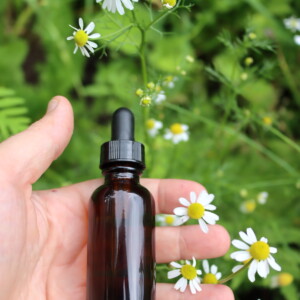
Chamomile Tincture (& Alcohol Free Glycerite)
Chamomile tincture is a gentle herbal remedy for insomnia and anxiety in adults, as well as teething, fussiness, and colic in children. When used externally, it can also treat skin irritation and it's a natural antimicrobial.
Equipment
Ingredients
- Fresh or dried chamomile flowers
- Vodka or other high-proof alcohol *see notes for making a glycerite tincture
Instructions
- Begin by selecting either fresh or dried chamomile flowers. Fresh flowers should fill your mason jar about halfway, while dried chamomile will fill it a bit less, roughly one-third of the jar. The more compact the flowers, the less liquid you will have after extraction, so aim for a loose pack that allows room for the alcohol to permeate.
- Pour your chosen high-proof alcohol over the chamomile flowers. Vodka is a common choice because of its neutral flavor, but you can also use brandy or rum if you prefer a slightly different taste profile. The goal is to fully cover the flowers with alcohol, ensuring they are submerged by at least 1 to 2 inches to avoid exposure to air, which can cause mold.
- Secure the lid on the jar tightly, and give it a good shake to mix the flowers and alcohol. Then, place the jar in a cool, dark spot, such as a cupboard or pantry. Let the chamomile steep in the alcohol for 4 to 6 weeks, allowing the tincture to develop its soothing properties.
- For the best extraction, gently shake the jar every 1 to 2 days. This helps ensure the flowers are evenly submerged and the tincture is extracting effectively. If you're using fresh chamomile, you may need to check that the flowers stay fully submerged, as fresh herbs tend to float. Add more alcohol if necessary.
- After about 4 to 6 weeks, strain the tincture through a fine mesh strainer or cheesecloth into a clean glass bottle. Press the plant material to extract as much of the liquid as possible. Discard the used flowers, as they’ve already given up their medicinal properties to the tincture.
- Label your tincture bottle with the date of preparation, the contents (Chamomile Tincture), and any dosage or usage notes. Store it in a cool, dry place, away from direct sunlight. Chamomile tincture will keep for several years when stored correctly.
Notes
Vodka is the most commonly used alcohol for tinctures, thanks to its clean, neutral flavor. You can also opt for brandy or rum if you want to introduce a different flavor profile, but ensure the alcohol is at least 60-proof (30% ABV) to ensure proper preservation of the tincture.
Never use isopropyl alcohol or denatured alcohol, as these are not safe for consumption.
Expected Yield
Fresh chamomile flowers will release some moisture into the tincture, so you'll likely end up with a little more liquid than you initially add. Dried flowers will absorb some of the alcohol, resulting in a slightly lower yield. For a quart jar, you’ll typically need about 2 to 3 cups of alcohol, or about 1 to 1.5 cups for a pint jar. Make sure the chamomile flowers stay submerged throughout the extraction process for the best results.Alcohol-Free Option: Glycerite
If you prefer a non-alcoholic option, you can create a chamomile glycerite tincture using vegetable glycerin instead of alcohol. For this method, cover your dried chamomile with a 3:1 mixture of glycerin to distilled water. If you’re using fresh chamomile, you can skip the water and use all glycerin. Shake the jar daily and strain it after 6 to 8 weeks, just as you would with the alcohol-based tincture. Chamomile glycerite is one of the most common types of alcohol-free tinctures since it’s commonly made for and given to young children. Since it’s especially popular with teething or fussy infants, having an alcohol-free version can be extra helpful for the little ones in your life. Of course, always ask your pediatrician before trying any new remedy, herbal or otherwise. Tried this recipe?Let us know how it was!